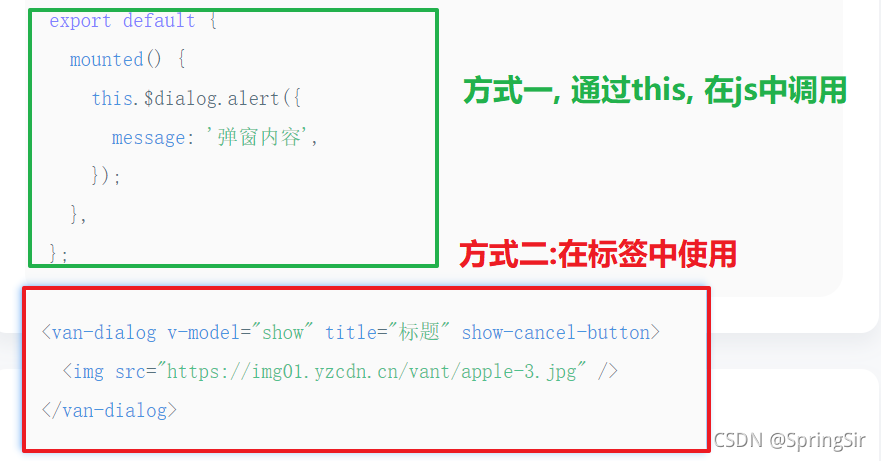web面试vue自定义组件及调用方式
引入:
由于项目需求, 部分相同的代码我们会封装成组件, 在需要使用的地方导入,
并以标签的形式书写在中,
但是在"vant"组件库中, "Dialog 弹出框"组件有2中使用方式

通常我们自定义组件, 一般也是通过方式二的形式使用, 今天介绍方式一如何使用
编码实现
以插件的形式使用组件
// 将要显示的组件导入
import mymodel from '../components/mymodel.vue'
export default {
install: function (Vue) {
// 1.0 根据 mymodel 组件对象得到它的构造函数
const Mymodel = Vue.extend(mymodel)
// 给所有的 vue 实例添加一个方法 $model
Vue.prototype.$model = function () {
// 为了显示一个组件: mymodel
// 2.0 创建一个组件对象
const obj = new Mymodel()
// 3.0 将组件显示出来
obj.show = true
// 4.0 得到组件对象的 html 结构
const html = obj.$mount().$el
// 5.0 将 html 结构渲染到页面上
document.body.append(html)
}
}
}
使用
<template>
<div>
<h3>以普通组件的方法来调用</h3>
<button @click="fn1">show Model</button>
<!-- <mymodel :value="show" @input="val => (show = val)"></mymodel> -->
<mymodel v-model="show"></mymodel>
<!-- sync:向组件内传入了参数: xxx 从组件中接收了事件:update:xxx 事件会自动修改 xxx -->
<!-- v-model:向组件内传入了参数: value 从组件中接收了事件:input 事件会自动修改 value -->
<h3>以 js 方式来调用</h3>
<button @click="fn2">show Model</button>
</div>
</template>
<script>
import mymodel from '../../components/mymodel.vue'
export default {
data () {
return {
show: false
}
},
methods: {
fn1 () {
this.show = true
},
fn2 () {
// 通过 js 的方法直接将组件显示出来
this.$model()
}
},
components: {
mymodel: mymodel
}
}
</script>
<style></style>
以上就是web面试vue自定义组件及调用方式的详细内容,更多关于web面试vue的资料请关注我们其它相关文章!
赞 (0)

